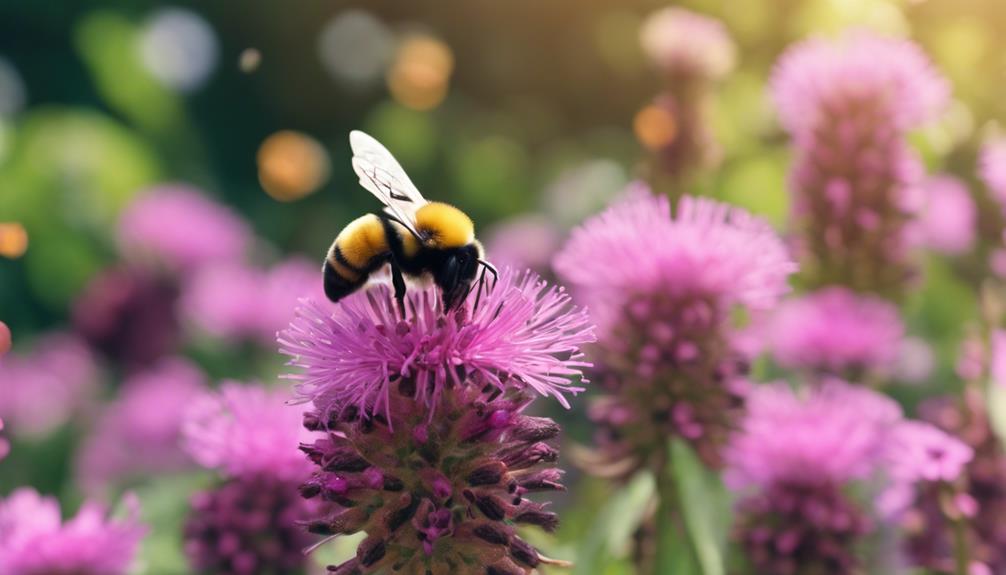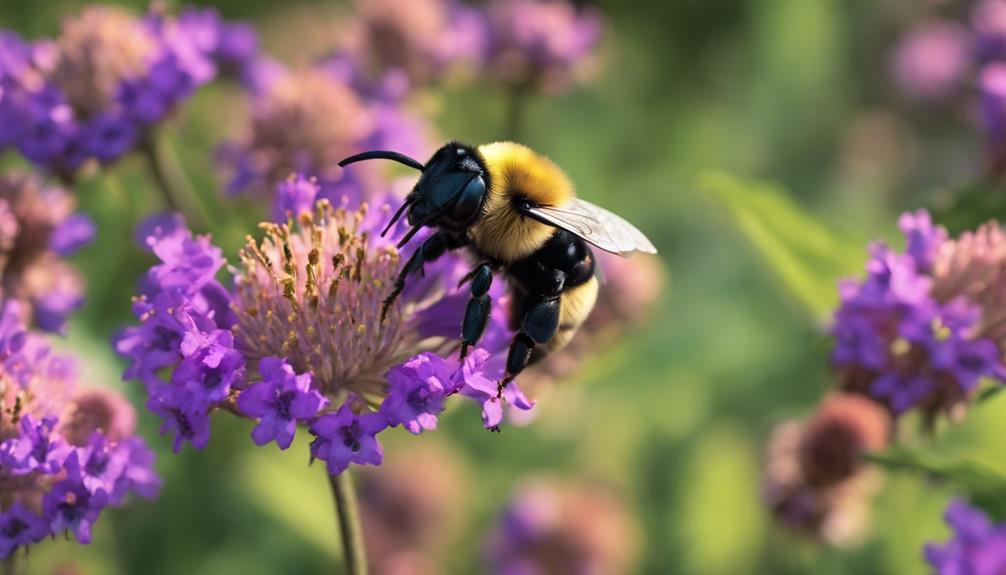Stingless bees, those captivating little creatures, are our native honey makers, buzzing around and creating delicious honey while also pulling their weight in pollination duties. These tiny wonders have a gentle demeanor and produce honey that captures the essence of the various flowers they visit, giving it a unique and diverse flavor profile. In regions hosting 16 distinct species of stingless bees, the honey’s taste can range from floral to fruity notes, a proof of the rich biodiversity these bees interact with daily. So, if you’re intrigued by the secret world of these miniature honey producers, there’s a whole lot more to learn about their incredible contributions.
Main Points
- Stingless bees are native bees that produce honey.
- They play a crucial role in pollination.
- Honey reflects the diverse floral sources.
- Stingless bees in Mexico and Central America are renowned honey producers.
- Sustainable practices support native bee honey production.
Stingless Bees: Natures Honey Producers
Stingless bees, like Melipona species, are natural honey producers that play an important role in pollination. These native bees are crucial for our ecosystem, guaranteeing the pollination of various plants and the production of unique honey.
Unlike their stinging relatives, these bees are gentle and don’t pose a threat, making them a joy to have around. The honey they produce isn’t only delicious but also mirrors the diverse floral sources in their environment, giving it a special taste that varies based on location.
By supporting sustainable beekeeping practices, we can help safeguard these stingless bees and ensure the continuation of their honey production for generations to come.
Let’s celebrate these incredible creatures and their sweet contributions to our world!
Unique Characteristics of Native Bee Honey
Indigenous bee honey displays a variety of flavors impacted by the nearby floral sources of nectar. Here are some unique characteristics of native bee honey:
- Native species like stingless bees in Mexico and Central America excel in honey production.
- These regions are home to 16 distinct species of stingless bees renowned for their honey-making skills.
- Stingless bee honey, such as Melipona honey, offers unique flavors influenced by the diverse floral sources they collect nectar from.
- The different environments and plant varieties in each region result in a broad range of honey flavors, making each batch a delightful and unique experience.
The rich biodiversity of native stingless bees contributes to the exceptional and diverse flavors found in their honey.
Importance of Native Bees in Honey Production

Acknowledging the crucial role of indigenous bees in honey production enriches our understanding of the intricate network of ecosystem functions.
While native U.S. bee species don’t produce honey, stingless bees native to Mexico and Central America are renowned for their honey-making abilities. These regions boast 16 unique species of stingless bees that contribute not only to honey production but also to the essential process of pollination, supporting overall ecosystem health.
The diverse floral sources available in each region where native stingless bees reside result in distinctive honey flavors, making each batch a true reflection of the local environment.
Factors Influencing Native Bee Honey Flavor
In regards to the flavor of native bee honey, a variety of factors come into play. The floral sources the bees visit, the unique foraging habits of different bee species, and the local plant diversity all contribute to the diverse taste profiles of native bee honey.
From floral and fruity notes to hints of herbs, the flavors of native bee honey truly reflect the rich biodiversity of the region.
Honeybee Vs. Native Bees
Indigenous bees, separate from honeybees, contribute to a varied array of honey flavors influenced by different factors like floral sources. When comparing honeybee honey to that of native stingless bees, there are some distinct differences worth noting:
- Honey Production: While honeybees are known for their abundant honey production, native bees in the US don’t produce honey themselves.
- Unique Species: Stingless honey bees native to Mexico and Central America offer 16 unique species that are known for producing honey.
- Floral Influence: Each region with native stingless bees provides unique honey flavors influenced by diverse floral sources.
- Distinct Flavors: Stingless bee honey, like Melipona honey, can feature a range of unique flavors such as lemony or sour tones.
Floral Sources Influence
Floral sources significantly shape the distinct flavors found in indigenous bee honey. When indigenous bees collect nectar from local flora, they capture the essence of their environment, infusing the honey with a unique taste reflective of the surrounding plant life.
The nectar gathered from different flowers imparts varying notes to the honey, creating a diverse range of flavor profiles. This connection to local flora means that each region’s indigenous bee honey carries a taste signature specific to its surroundings.
Whether it’s the subtle hints of citrus from orange blossoms or the robust undertones of lavender fields, the influence of floral sources on indigenous bee honey is unmistakable. Exploring the world of indigenous bee honey offers a delicious journey through the botanical tapestry of nature’s bounty.
Sustainable Harvesting Practices for Native Bee Honey

In regards to harvesting native bee honey sustainably, our primary focus is on preserving bee habitats and promoting eco-friendly collection methods.
By safeguarding these crucial habitats and minimizing disruptions to natural nesting sites, we can support the health and longevity of native bee colonies.
It’s all about maintaining a delicate balance that benefits both the bees and the environment they thrive in.
Eco-Friendly Honey Collection
Our approach to sustainable harvesting of native bee honey prioritizes the well-being of bee colonies and the preservation of their natural habitats. When collecting honey from our native bee populations, we guarantee that our practices are eco-friendly and support conservation efforts.
- Use non-destructive methods to collect honey without harming bee colonies.
- Employ specific hive designs and tools for gentle honey extraction.
- Aim to maintain the natural habitats of native bees.
- Support the vital role of native bees in pollination through sustainable harvesting.
Preserving Bee Habitats
Preserving bee habitats for sustainable harvesting of native bee honey involves implementing conservation practices that protect natural ecosystems and minimize human interference. By supporting conservation efforts, we safeguard the homes of native bee species essential for ecosystem health.
Sustainable harvesting methods strike a balance between honey production and bee preservation, ensuring the long-term sustainability of both. Through responsible beekeeping practices, local beekeepers play a key role in protecting native bee populations and their habitats. These efforts not only benefit the bees but also contribute to the overall health of the environment.
Supporting Native Bees for Ecosystem Health
Supporting native bees for ecosystem health is essential for maintaining biodiversity and preserving ecological balance. Here are four ways we can help these crucial pollinators thrive:
- Create Pollinator-Friendly Gardens: Planting a variety of flowers and native plants provides food and shelter for native bees.
- Avoid Harmful Pesticides: Opt for organic and bee-friendly pest control methods to protect native bee populations from toxic chemicals.
- Support Habitat Preservation: Encourage conservation efforts and initiatives that aim to safeguard natural habitats where native bees live and forage.
- Enhance Crop Pollination: By promoting healthy native bee populations, we not only benefit wild plants but also support the pollination of commercial crops, ensuring a balanced ecosystem for all.

Hello! My name is Noel Calvin. I graduated from UCLA and now work as a writer at Launch Ninjas. I write blog posts that inspire and guide our readers in their entrepreneurial pursuits. I live in Pleasantville, NJ, with a peaceful yet lively atmosphere that inspires me.
Writing stories is more than just a job for me. It allows me to share my observations and satisfy my curiosity about the world. I combine my analytical skills with creative enthusiasm to delve into technology trends and startup stories. But my life isn’t limited to screens and keyboards. I value loyalty, passion, and a touch of old-fashioned charm, which I infuse into every narrative I create.
I love spending time in my garage, jamming with my band when I’m not writing. Playing the guitar and singing bring me immense joy. I also enjoy capturing ordinary and extraordinary moments through my camera lens and exploring new culinary adventures that excite my taste buds. I’m always seeking new experiences.
My family is very important to me. Joyful Sunday brunches filled with laughter and intense board game nights keep me grounded, reminding me of life’s simple pleasures.
In my world, every moment is an opportunity for discovery. Every discovery is a story worth sharing, whether a heartfelt moment at home or the pulse of technological innovations. Join me as I navigate through life, one blog post, one guitar strum, and one heartwarming family dinner at a time.


